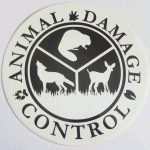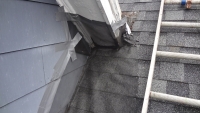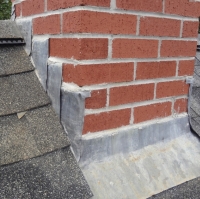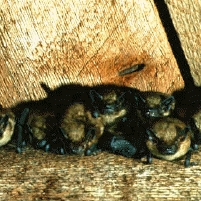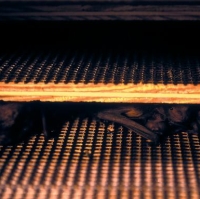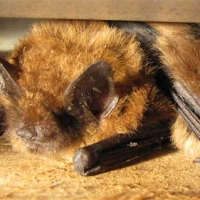- Bats
-
-
If you think that you or
someone in your care has been bitten by a bat or been in contact
with a bat, call the Maine Center for Disease Control (CDC)
immediately at 800-821-5821.
-
-
Although the likely hood
of contacting rabies from bats is relatively low, it's worth
following up on testing and treatments considering that if you
contract the rabies virus and it is not treated the outcome is
almost always death. If you wake up in the morning to find bats have
been in the room with you during the night while you are sleeping it
is worth while to try and capture the bat and take it to Augusta to
determine whether or not the bat is carrying the rabies virus or
not. We have provided several links to assist you at the bottom of
this page.
-
-
Aside from an unexpected
surprise in the morning, the most common time of the year for bats
to show up is in early spring. During this time they are migrating
from large hibernacula (structure where many bats over winter) into
new areas for living. It is here where they are able to raise their
young for the year. Pups are born between Mid-May until Late July,
and this is the time when calls begin to peak. The young begin
exploring and wandering away form their parents as they begin
testing out their new wings. This is the time of year that is very
common for calls about bats inside the living areas. Often times,
they have been living in the attics or wall voids in the roof since
spring and were not noticed until the young finally made it into the
living area.
-
-
Typical service calls for
bats include inspection and sealing of all living quarters from the
rest of the house. Maine Wildlife Exclusion Services approaches this
method regardless the time of year, even when full evictions are
possible. Sometimes, with even limited bat proofing on the exterior
of the home, the air currents flowing through the house can be
altered enough to send bats down into living areas. It is our goal
to avoid this situation whenever possible. Some instances such as
unfinished camps, or renovations and construction within a building
can cause its own set of problems trying to seal bats out. Upon
inspection we can give you a realistic expectation of likely costs
and procedures to evict bats form your home and keep them out.
-
-
The Maine Wildlife
Exclusion Services Approach to Bat Exclusion
-
-
1. Seal the inside of the
house as much as possible so bats cannot enter living areas.
-
-
2. Consider time of year.
Early Spring into early May, and Late August into the Fall, full
exclusion of bats from the building can be performed.
-
-
Mid-May through August,
only limited bat exclusion work will be performed. It is during this
time of the year that pups are still developing, yet may not be able
to fly yet. Excluding bats during this time of year could result in
bats being trapped in the structure and dying. If bats are in the
structure at this time of year, every effort will be made to try and
determine the possibility of maternal colonies, but it can not
always be determined. Emphasis would be placed on ensuring young
bats can enter into living areas by sealing the structure from the
inside. After the young bats were flying, full exclusion of all bats
could be performed.
-
-
3. Seal and close all
openings a bat may use to enter the home after excluding bats. The
Little Brown bat is our most common bat found in homes, followed by
the Big Brown bat. Little Brown bats can enter an opening in a
building measuring roughly ¼"x1½".
-
-
When buildings are
constructed, they are designed to shed water and ventilate air
within the extremes of climates. Being rain proof and breathable
does not mean that the house is bat proof. Our exclusion involves
going over all portions of the house and identifying and sealing all
potential entry points.
-
-
With White Nose Syndrome
dramatically affecting bat populations throughout the Northeast and
across North America, Maine Wildlife Exclusion Services does not
endorse euthanizing bats unless a bat is suspected of possibly haven
bitten someone. Maine Wildlife Exclusion Services encourages
everyone to try and support bat populations. A higher bat population
equates to a lower mosquito and black fly population.
-
-
For more information
try the following links:
-
-
Bat Conservation
International is a is devoted to conservation, education, and
research initiatives involving bats and the ecosystems they serve.
They have a great source of information here including building bat
houses and information about everything bats.
http://www.batcon.org/index.php/bats-a-people.html
-
-
Our business is listed
here, as is other areas businesses dealing with bats. There are lots
of great follow on links from many universities and government
agencies covering rabies, exclusion, and dealing with bats. Very
informative.
http://www.maine.gov/agriculture/pesticides/gotpests/othercritters/bats.htm
-
-
Everything you could ever
want to know about rabies in Maine.
-
http://www.maine.gov/dhhs/mecdc/infectious-disease/epi/zoonotic/rabies/index.shtml
-
-
Some information on White
Nose Syndrome from Inland Fisheries and Wildlife
http://www.maine.gov/ifw/wildlife/disease/WhiteNoseSyndrome.htm
-
-
-
|
click photos to enlarge
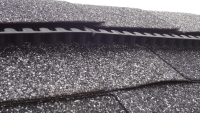
Bad roof ridge vent is an invitation to bats
|
 Maine Wildlife
Maine Wildlife 